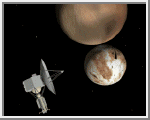













|

NASA Pluto/Charon Flyby
Courtesy of NASA's National Space Science Data Center
Originally designated the Pluto Fast Flyby (PFF), the Pluto Express mission is planned to be a two-spacecraft mission designed to make studies of the planet Pluto and its satellite Charon. Its major science objectives are to: (1) characterize the global geology and geomorphology of Pluto and Charon; (2) map the composition of Pluto's surface; and, (3) determine the composition and structure of Pluto's atmosphere.
Pluto has a tenuous atmosphere that only exists when the planet is closest to the Sun. Pluto Express is designed to reach the planet as quickly as possible, before the tenuous can refreeze onto the surface as the planet recedes from the Sun. The two spacecraft are scheduled for launch beginning in 2001, with expected arrival at Pluto around 2013. Studies of the double-planet system will begin 12-18 months prior to closest approach.
The overall structure of the spacecraft is an aluminum hexagonal bus with no deployable structures. Power will be provided by radioisotope thermal generators (RTGs) similar in design to those used on earlier missions (e.g., Galileo). Communications will be via a fixed, 1.47 meter high-gain antenna employing an X-band uplink receiver and downlink transponder. Pointing control will be maintained by a wide-field star tracker and a set of three solid-state rate sensors. The on-board computer is a 1.5 MIPS RISC-based system capable of processing a science data stream of 5 Mbps. The solid-state data storage system is capable of storing 400 Mb in both compressed and uncompressed formats. Strawman experiments for the spacecraft include a visible-light imaging system, an infrared mapping spectrometer, an ultraviolet spectrometer, and a radio occultation experiment utilizing an ultrastable oscillator (USO) and the on-board telecommunications system.
Prototype instruments were delivered from Jet Propulsion Laboratory and other investigators in 1994. They were able to demonstrate that science goals can be met with an ultraviolet/visible/infrared radio science flight instrument total weighing less than 7 kg, and using less than 6 W. A potential cooperative effort with Russia may lead to the inclusion of Zond probes, to study the Plutonian atmosphere.
Views of the Solar System Copyright © 1997-2000 by Calvin J. Hamilton. All rights reserved. Privacy Statement.